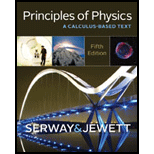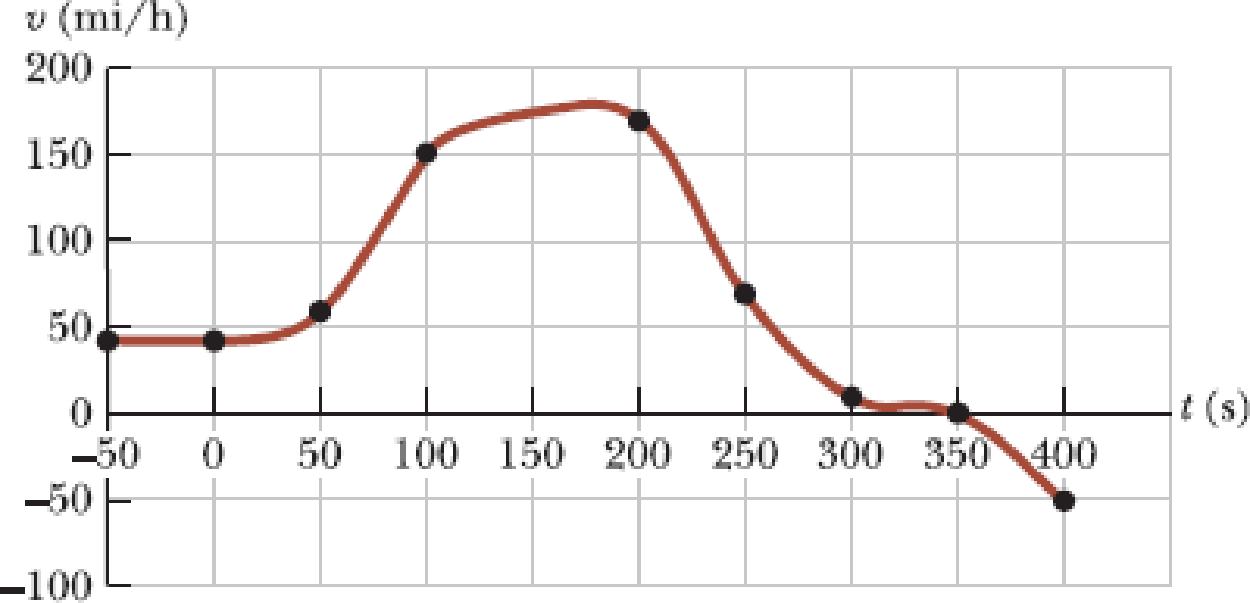
Concept explainers
The Acela is an electric train on the Washington–New York–Boston run, carrying passengers at 170 mi/h. A velocity–time graph for the Acela is shown in Figure P2.46. (a) Describe the train’s motion in each successive time interval. (b) Find the train’s peak positive acceleration in the motion graphed. (c) Find the train’s displacement in miles between t = 0 and t = 200 s.
Figure P2.46 Velocity versus time graph for the Acela.

(a)
The description of the train’s motion in each successive time interval.
Answer to Problem 46P
Initially A is moving at constant positive velocity in the
Explanation of Solution
In the given velocity versus time graph of A, the curve is parallel to the time axis in the interval
From around
Conclusion:
Thus, initially A is moving at constant positive velocity in the
(b)
The train’s peak positive acceleration in the motion graphed.
Answer to Problem 46P
The train’s peak positive acceleration in the motion graphed is
Explanation of Solution
The slope of the graph in a given interval gives the acceleration of the object during it. The region of steepest slope in the
Write the equation for the acceleration of the object.
Here,
Write the equation for the slope.
Here,
Put the above equation in equation (I).
Conclusion:
Substitute
Therefore, the train’s peak positive acceleration in the motion graphed is
(c)
The train’s displacement in miles between
Answer to Problem 46P
The train’s displacement in miles between
Explanation of Solution
The cumulative area under the velocity versus time graph between
The velocity versus time graph is shown below.

Write the equation for the area of a rectangle.
Here,
Write the equation for the area of a triangle.
Here,
The area from
In figure 1, the length of the rectangle from
Substitute
Here,
The area from
In figure 1, the length of the rectangle from
Substitute
Here,
In figure 1, the base of the triangle from
Substitute
Here,
The area from
In figure 1, the length of the rectangle from
Substitute
Here,
In figure 1, the base of the triangle from
Substitute
Here,
Write the equation for the net displacement.
Here,
Conclusion:
Substitute
Therefore, the train’s displacement in miles between
Want to see more full solutions like this?
Chapter 2 Solutions
Principles of Physics
- Figure P2.15 shows a graph of vx versus t for the motion of a motorcyclist as he starts from rest and moves along the road in a straight line. (a) Find the average acceleration for the time interval t = 0 to t = 6.00 s. (b) Estimate the time at which the acceleration has its greatest positive value and the value of the acceleration at that instant. (c) When is the acceleration zero? (d) Estimate the maximum negative value of the acceleration and the time at which it occurs. Figure P2.15arrow_forwardColonel John P. Stapp, USAF, participated in studying whether a jet pilot could survive emergency ejection. On March 19, 1954, he rode a rocketpropelled sled that moved down a track at a speed of 632 mi/h (see Fig. P2.56). He and the sled were safely brought to rest in 1.40 s. Determine in SI units (a) the negative acceleration he experienced and (b) the distance he traveled during this negative acceleration.arrow_forwardFigure P2.15 shows a graph of vx versus t for the motion of a motorcyclist as he starts from rest and moves along the road in a straight line. (a) Find the average acceleration for the time interval t = 0 to t = 6.00 s. (b) Estimate the time at which the acceleration has its greatest positive value and the value of the acceleration at that instant. (c) When is the acceleration zero? (d) Estimate the maximum negative value of the acceleration and the time at which it occurs.arrow_forward
- Between t = 0 and t = t0, a rocket moves straight upward with an acceleration given by a(t) = A − Bt1 /2 , where A and B are constants. (a) If x is in meters and t is in seconds, what are the units of A and B? (b) If the rocket starts from rest, how does the velocity vary between t = 0 and t = t0? (c) If its initial position is zero, what is the rocket’s position as a function of time during this same time interval?arrow_forwardA woman swims the length of a 120-m pool and back again (one lap) in 90 s with a constant speed. 2.) What is her average velocity for one lap? a. 0 b. 1.33 m/s c. 2.67 m/s d. 0.67 m/sarrow_forwardColonel John P. Stapp, USAF, participated in studying whether a jet pilot could survive emergency ejection. On March 19, 1954, he rode a rocket-propelled sled that moved down a track at a speed of 632 mi/h (see figure below). He and the sled were safely brought to rest in 1.40 s. (a) Determine in SI units the negative acceleration he experienced. (m/s2) (b) Determine in SI units the distance he traveled during this negative acceleration. (m)arrow_forward
- a tennis ball is thrown straight up and caught at the same height on the way down. which of the following can describe the motion of the ball when it reached its maximum height? a. The acceleration of the ball is zero b. The acceleration of the ball is 9.8 m/s^2 down c. b. The acceleration of the ball is 9.8 m/s^2 down d. The velocity of the ball is zeroarrow_forwardThe first astronaut has landed on Mars. Conducting some physics experiments, she drops a hammer from rest from a height of 2.01 m and uses a stopwatch to measure that the hammer takes 1.04 s to hit the ground. A. Determine the magnitude of the acceleration due to gravity on Mars. B. She then throws the hammer straight up into the Martian sky. If she comes back to her hand in 4.20 s, with what speed did she throw it?arrow_forwardA racing car traveling with constant acceleration increases its speed from 10 m/s to 30 m/s over a distance of 60 m? How long does this take? Group of answer choices 6.0 s 3.0 s 2.0 s The time cannot be calculated since the speed is not constant 5.0 sarrow_forward
- A European sports car dealer claims that his product will accelerate at a constant rate from rest to a speed of 100 km/hr in 8.00 s. What is the speed after the first 4.00 s of acceleration? (Hint: First convert the speed to m/s.)arrow_forwardReferring to the figure, a truck drives a distance d=30.1m in the positive x direction in a time t1=17.2s, at which point the truck brakes, coming to rest in t2=8.13s. Part A: What is the truck's average velocity in the horizontal direction, in meters per second, during the t1 time period? Part B: Assuming the truck started from rest and moved with a constant acceleration, what was the acceleration, in meters per suqared second, during the time interval t1? Part C: What was the truck's instananeous velocity in the horizontal direction, in meters per second, when it began braking? And using the result from the previous answer, what was the truck's horizontal component of acceleration, in meters per squared second, during the braking period? Please explain how you got your answer in detail.arrow_forwardThe graph shows the time records of the position, velocity, and acceleration of a hummingbird, as it hovers back and forth along a straight line near a tempting feeder, trying to decide if it wants to take a drink of nectar. The units for the quantities are m, m/s, and m/ s2s2. Which is which? a. Position: B; Velocity: C; Acceleration: A b. Position: C; Velocity: A; Acceleration: Bc. Position: A; Velocity: C; Acceleration: Bd. Position: C; Velocity: B; Acceleration: Ae. Position: B; Velocity: A; Acceleration: Carrow_forward
 Principles of Physics: A Calculus-Based TextPhysicsISBN:9781133104261Author:Raymond A. Serway, John W. JewettPublisher:Cengage Learning
Principles of Physics: A Calculus-Based TextPhysicsISBN:9781133104261Author:Raymond A. Serway, John W. JewettPublisher:Cengage Learning
